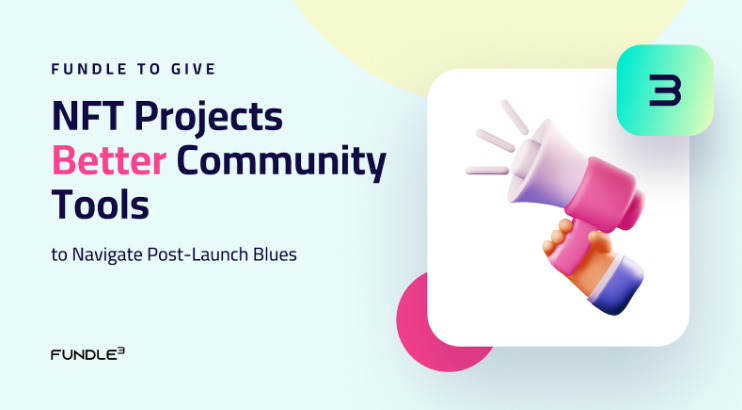NFTs are the future of marketing, customer engagement and loyalty. True digital ownership is what empowers communities to have a stake in what they are building and that ownership is cradled in NFT technology. These NFTs are way more than just pictures of apes. Rather, they are a set of keys to a shared mission, a membership card to an exclusive club, a loyalty or incentive program, and the pillars around which ecosystems of community and value can surround. Despite all the hype, they are still in their infancy, and their true potential remains only fleetingly explored.
One of the primary utilities of an NFT in a collection is the connection it provides to the community of fellow owners and the project itself. Any organization, initiative, community, project, or group that uses NFTs to grant membership is doing so to enshrine its community as a beneficiary of its activities. Fundle is an all-in-one NFT community engagement platform that helps projects manage their community of owners once the collection is released. It helps project leaders measure the success of their initiatives, identify key participation metrics, and capture and return value to their communities.
A company has made a successful NFT launch. They tapped into Discord, Twitter, and Telegram channels, and added some marketing muscle through their traditional channels, and have now built a strong presence in web3 with their brand.
Then it gets harder. 99% of NFT collections, even those that sell out quickly, fail to engage their community long term. Keeping your communities attention, genuinely delivering on roadmaps, and creating meaningful utility that sets your collection apart. These are the hard tasks.
It’s a task made harder still by ineffective community management tools. It’s hard to measure the success of a community. Discord emoji reactions are a difficult metric to gauge, and member numbers are easily inflated. The hypernoise of the social internet, and parsing it the right way, is a key area that companies, both traditional and web3, are constantly trying to improve – and NFT projects are no different. Trading data can be skewed by just a few high frequency actors, or even bots. And the floor price can fluctuate not only due to wider market trends, but price movements in the denominating token itself.
More problematic still is the inability to combine on and off-chain data to build a wider picture of the community and have easy channels to interact. World of Women, a prominent NFT collection, says ‘our tech team manually combines data from raffles and other sources’. It’s desperately inefficient – and could be so much easier. Another huge problem is simply knowing what the community wants. A team may spend hundreds of hours organising a token drop for their holders, or building a browser game where they can use their NFT, not realising that their community really wants a whitelist for other projects, or vice versa.
It all leads to wasted time and utility no one needs or wants. For bedroom startups just figuring it out, that may be okay, but for larger brands like Budweiser and Gucci who have entered the NFT space, that is an expense they can’t afford, and can damage the trust they are trying to develop in web3. These brands already have loyal customers, and those loyal customers are happy to buy their NFT, but brands remain unaware of how to capitalise on their newly acquired market segment in web3.
Fundle solves all this. It analyses NFT holders on-chain behaviour, tracks engagement behind Discord and Twitter, and allows issuance of custom forms to capture data. These critical metrics are combined into a single view, where you can, at a glance, find out what campaigns and actions are having a lasting impact. The custom forms Fundle allows you to issue can act as claim pages for various utilities offered by an NFT. So, if you were distributed an associated token, you could capture data from the community as they come to claim it, and record uptake more efficiently and easily, rather than having to deep dive into on-chain analytics yourself only to get less useful and searchable data at the end of it.
This real-time overview gives project owners and companies who’ve launched NFTs a powerful way to understand the success of their various NFT collections and the ongoing engagement they are enjoying. As well as tracking on-chain activity, you can combine the data with that data from off-chain initiatives to form a comprehensive picture of exactly what makes your community tick.
Projects and companies interested in taking advantage of Fundle’s tools can go to their website to schedule a demo. After that, they’ll be onboarded into the closed beta program. The beta will be free of charge for companies and Fundle hopes to work closely with organisations using their tools to get the best possible feedback and ensure it meets their needs.
NFTs and their ability to bind communities together will continue to take market share from traditional web2 influencer and loyalty programs. As more brands and individuals become comfortable with using web3 – in part due to tools like Fundle that help propel it – NFTs will be a standard way for projects and followers to interact. Fundle has already worked with high-profile pilot customers for their corporate services, and when their beta launches many NFT collections with strong communities will be eager to utilise their services, getting the data they need to take their project to the top.
CryptoMode produces high quality content for cryptocurrency companies. We have provided brand exposure for dozens of companies to date, and you can be one of them. All of our clients appreciate our value/pricing ratio. Contact us if you have any questions: [email protected] None of the information on this website is investment or financial advice. CryptoMode is not responsible for any financial losses sustained by acting on information provided on this website by its authors or clients. No reviews should be taken at face value, always conduct your research before making financial commitments.


